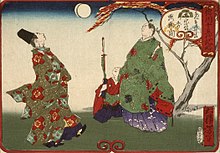Kemari




Kemari(Đá cầu)is an athletic game that was popular inJapanduring theHeian(794–1185) andKamakura period(1185–1333). It resembles a game ofkeepie uppieorhacky sack.The game was popular inKyoto,the capital, and the surroundingKinki(Kansai region), and over time it spread from the aristocracy to thesamuraiclass andchōninclass. Nowadays,kemariis played as a seasonal event mainly atShinto shrinesin the Kansai region, and players play in a costume calledkariginu(ja: Thú y), which was worn as everyday clothing by court nobles during the Heian period.[1]
History[edit]
The earliestkemariwas created under the influence of theChinesesportcuju,which has the samekanji.[2]It is often said that the earliest evidence ofkemariis the record of 644 CE in theNihon Shoki,[3]but this theory is disputed. In 644,Prince Naka-no-ŌeandNakatomi no Kamatari,who later initiated theTaika Reforms,became friends during a ball game described as "Đánh cúc", but it may have been a hockey-like ball game using a cane instead ofkemari.The earliest reliable documentary evidence of the wordkemari( đá cầu ) is found in a record of an annual event calledHonchō gatsuryo(ja: Bổn triều thời tiết và thời vụ) written in the middle of the Heian period. According to the records, akemarigames were played in May 701.[1]
Kemaribecame popular as a game for the nobility in the lateHeian period(794–1185) in the 11th century, and in the 12th century, Fujiwara no Narimichi (ja: Đằng nguyên thành thông) and Nanba Yorisuke (ja: Khó sóng lại phụ) gained fame as masters ofkemari.Fujiwara no Narimichi had made more than 50 visits to theKumano Hongū Taishato pray that hiskemariskills would improve, and he had performed thekemarifeat known as aushiro mari( sau ろ cúc, backward ball) in front of the shrine whereSusanoowas enshrined. This technique is akeepie uppieperformed on the heel.[1]
It reached its peak between the end of the 12th century and around the 13th century in the earlyKamakura period(1185–1333), andkemarigames were often played during the reign ofMinamoto no Yoriie.This led to the establishment of a variety of new rules, equipment and techniques, and the completion of a structured art form calledkemaridō( đá cầu nói ). In the Kamakura period,kemaribecame popular among thesamuraiclass, and in theMuromachi period(1336–1573),kemari,along with various other performing arts such aswaka(Japanese poetry) and theJapanese tea ceremony,was regarded as one of the art forms that the samurai class was encouraged to master.[1][4]
In theSengoku period(1467–1615),sumobecame popular andkemarideclined, but in theEdo period(1683–1868) it became popular again as a game played bychōninclass in theKinai(Kansai region).[1]
In the past, aristocrats living inKyotoused to playkemarias an annual event on New Year's Day, January 4.Emperor Meijifeared that the rapid modernization of Japan would lead to the loss of various traditional Japanese cultures, and in 1903, an association was established to preservekemariby contributing an imperial grant. Today,kemariis performed as a seasonal event inShinto shrinesaround theKansai regionsuch asShimogamo Shrine,Shiramine Jingū,Fujimori Shrine (ja: Đằng sâm thần xã),Tanzan Shrine,Hirano ShrineandKotohira-gū.Seidaimyōjin ( tinh đại minh thần ), enshrined as one of thesessha(auxiliary shrine) of Shiramine Shrine, is thekamiof themari(kemariball) and is therefore respected by players of various ball games, mainlyassociation football.[1]
George H. W. Bushplayed the game on one of his presidential visits to Japan.[5][6]
Description[edit]
It is a non-competitive sport.[7]The object of Kemari is to keep oneballin the air,[2]with all players cooperating to do so. Players may use any body part with the exception of arms and hands: their head, feet, knees, back, and depending on the rules, elbows to keep the ball aloft. The ball, known as amari,is made of deerskin with the hair facing inside and the hide on the outside. The ball is stuffed with barley grains to give it shape. When the hide has set in this shape, the grains are removed from the ball, and it is then sewn together using the skin of a horse. The one who kicks the ball is called amariashi.A good mariashi makes it easy for the receiver to control the mari, and serves it with a soft touch to make it easy to keep the mari in the air.
Kemariis played on a flat ground, about 6–7 meters squared.[3]The uniforms that the modern players wear are reminiscent of the clothes of the Heian period and include a crow hat. This type of clothing was calledkariginu(ja: Thú y) and it was fashionable at that time.
See also[edit]
References[edit]
- ^abcdefThần xã と thâm くつながる “Đá cầu”(in Japanese).Kokugakuin University.Archived fromthe originalon 5 December 2022.Retrieved5 December2022.
- ^abWitzig, Richard (2006).The Global Art of Soccer.CusiBoy Publishing. p. 5.ISBN9780977668809.Retrieved2010-07-08.
- ^abAllen Guttmann, Lee Austin Thompson (2001).Japanese sports: a history.University of Hawaii Press. pp. 26–27.ISBN9780824824648.Retrieved2010-07-08.
- ^Đá cầu(in Japanese). Kotobank/Digitalio, Inc/Asahi Shimbun.Archived fromthe originalon 5 December 2022.Retrieved5 December2022.
- ^Wines, Michael (1992-01-07)."On Japan Leg of Journey, Bush's Stakes Are High".The New York Times.
- ^Wines, Michael (1992-01-08)."Japanese Visit, on the Surface: Jovial Bush, Friendly Crowds".The New York Times.
- ^"History of Football".FIFA. Archived fromthe originalon December 25, 2012.Retrieved29 April2013.
External links[edit]
![]() Media related toKemariat Wikimedia Commons
Media related toKemariat Wikimedia Commons

